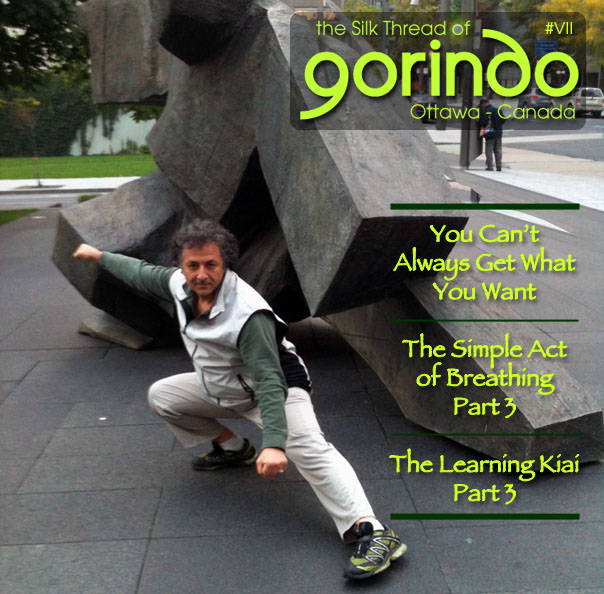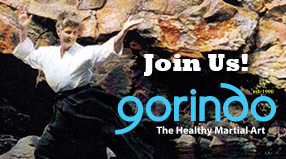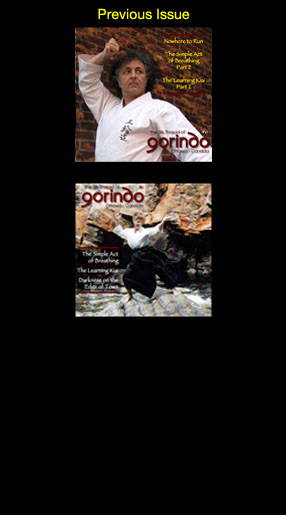
The Silk Thread of Gorindo - Ottawa - Canada
Issue VII
- The Simple Act of Breathing (Part 3)
- You Can't Always Get What You Want
Photo cover Claudio Iedwab sensei in Montreal, Sept 2010, by Roxanne Standefer
The Simple Act of Breathing (Part 3)
< read Part 2 (previous issue)
Breathing into warm-up
After the period of seiza at the beginning of a typical class or individual workout, the martial artist will do a series of exercises as a warm-up. The purpose of this is to raise the body temperature so that muscle and connective tissue will stretch and contract without damage. Breathing deeply can boost metabolism and activate energy stored in the chemical systems in the body. It is also important that the mental attitude and breathing rhythm from the zazen meditation be carried over into the warm-up, as it is here that the coordination of breathing and physical movement will be established and synchronized. The gentle stretches and rotations done to limber and loosen the joints and spine will be performed with slow exhalation, taking care to not hold the breath. If done correctly and with attention to the pattern and depth of breathing, a nice flowing movement of the body will result, and provide a good transition to the vigorous and demanding exercises to follow. A great warm-up can ensure a great class.
The Basics
Basic exercises, or kihon, can encompass a wide range of techniques practised in combination. These exercises are repeated rhythmically as learning drills for accuracy, strength, stamina and endurance. In gorindo, they can be performed either standing in one spot, or if there is space, moving back and forth across the floor or ground. In the throwing and grappling aspects the pattern of practice with partners may appear to be somewhat different, but the purpose of kihon to break down technique into component parts and then rebuild repetitively is the same.
Kihon is excellent training for the improvement of vital capacity, cardiovascular efficiency, and overall fitness and coordination.
Physical exercise
The closest parallel in conventional physical education is the aerobics exercise class of modern fitness clubs. In fact, the most recent trend in physical fitness training is the incorporation of martial arts and boxing techniques in these classes. Although martial art professionals are happy to see some recognition of the systems that they have been training in for decades, there is concern that there may be insufficient attention being paid to proper preparation and precise technique in order to avoid injury. While they do popularize the whole-body benefits that martial arts training can offer, without the mental and spiritual influence and the grounding in the breathing practices, these exercises provide to participants only a small part of the total “package.”
The workout
Kihon provides a good aerobic workout in which the mind is always engaged, focusing on accurate technique, breaking it down into parts, recombining, making movements flow with the breath. In more advanced martial arts training, intensive and long training sessions are designed for improving endurance, concentration, and reliance on correct technique to conserve energy. Here the body will pass from aerobic respiration (where oxygen is used directly) to anaerobic respiration, where lactic acid is formed in the muscle tissue and extended feelings of fatigue, both physical and mental, can set in. All forms of long distance or endurance exercise will engage the aerobic/anaerobic crossover effect. Good instruction and training can increase the time spent operating aerobically and considerably reduce the discomfort of the anaerobic metabolism. Although the physical effects of the body’s “changing of gears” are very real, the reaction to them and their influence on enjoyment and the desire to continue training, or more to the point, the perception of the ability of the body to continue, is largely mental.
A second wind
The martial artist is working to recognize and control this mind-body effect and use it to his advantage. Understanding and control of breathing is critical in being able to increase the limits of his physical endurance, and eliminate the anxiety induced when “waiting for that second wind,” by making that wind come to him. Breathing fuels the metabolic furnace of the body and affects the production of adrenaline and endorphins. These chemical and hormonal influences produce feelings of well-being, pain relief, and surges of energy and power. A martial artist seeks to access the virtually unlimited potential of the human body and spirit that we see demonstrated in situations in which, for example, a mother has to lift a tree branch off her injured child, or the survivor of a plane crash crosses hundreds of miles of bush to seek rescue.

Shingitai (mind body spirit)
Although the physical limits of most humans appears to be finite, it is often the will to survive and the ability to concentrate one’s energies on a single task that sets us apart. Learning to access and harness the body’s intrinsic physical resources, uniting the intellect, will, and passion, is the training goal of the martial artist. By recognizing the equilibrium required, and by studying the ebb and flow of these energies, the student or practitioner can work to direct these skills. At the same time, a martial artist is learning to let go, to go with the flow, and allow energy to come to him. This yin-yang balance between control and chaos is part of what makes the martial arts so challenging and interesting, both as an activity and a way of life.
Kata
Training in kata (a formal series of arranged movements), is the next step in the integration of natural flowing movements and breathing. Fast and slow, push and pull, grappling and jumping are all included in these moving meditations. Initially perceived as a teaching exercise, its role expands as the student progresses.
Kata is considered by some as the highest form of expression in the martial arts and is certainly where mind, body and spirit come together.
Endless repetition of kata, “polishing the diamond,” allows students eventually to let go of the mental and physical limitations of the training and breathe with the spirit of the art.
Putting it all together through breathing
The martial artist is using the breathing process of meditation in extreme moments of excellence or survival. By concentrating on the breathing in various levels of respiration, the brain acquires a focus that can be used to calm the mind or inspire it. Deep breathing can serve to both energize and relax at the same time. Feelings of anxiety that often result from the organism of the body being unsettled or stressed can be quelled, and the effects of adrenaline and other byproducts of the body’s metabolism can be controlled. As well, emphasizing the benefits of allowing the body to perform in optimum conditions, with a positive attitude, can significantly enhance one’s sense of general well-being and happiness. Just learning to relax can release great energy in the body and spirit. The old adage to “take ten deep breaths” to control anger or other emotions comes from this. Through training, the martial artist seeks to become more “present” in every moment. Being aware and engaging fully in the experience at hand is both a philosophical fundamental and a necessity for the martial artist. Communicating and expressing this with the physical senses, always brings us back to how we “breathe in” or absorb our environment, and continuously return energies back to it.
Excerpt from “The Secret Art of Health & Fitness – Uncovered from the Martial Arts Masters” by Claudio Iedwab & Roxanne Standefer
- The Simple Act of Breathing (Part 3)
- You Can't Always Get What You Want
« Click the Subscribe link on the left



